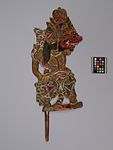wayang klitik (Shadow Puppet)
About this object
History of use
Javanese puppet theatre as an art form probably developed by the 11th century. The two-dimensional wooden wayang klikit puppets of Javanese shadow playss preceded the later and less sacred wayang golek puppets which appeared during the 16th century. Originally the plays depicted Javanese mythology, but after the Indian conquest of Java the Hindu epics, Ramayana and Mahabharata, were incorporated into the cycles, which comprise about 200 plays. The wayang klikit shadow plays form is thought to have originated in southern India; the wayang golek puppets are indigenous adaptations. Although the wayang klikit puppets are the older form, many symbolic elements remain the same. The shadow playss are performed by a dalang (puppet master) who is more formally a priest. An individual or group requests a dalang to celebrate important occasions. The performances often last all night and are generally presented in three acts, with vocal and instrumental accompaniment. The individual plays vary widely in detail but usually involve conflict between good and evil. They serve a moral and religious purpose, and more recently, one of political commentary. Each puppet's character is represented by its appearance and placement onstage; protagonists with strong elements of good are placed to the right, antagonists of violent or evil nature to the left. Damasuka appears in the Ramayana cycle; he provokes Rama by abducting his wife Dewi Sinta. More generally, ogres, who display many of Damasuka's traits, are an indigenous Javanese addition to the plays, providing a clear example of evil nature to contrast the characters of mixed disposition.
Cultural context
Theatrical performance.
Iconographic meaning
Rahwana type face with blunt nose, large eyes and large fangs are associated with ogres of irascible and unfaithful character. The size of the puppet, the crown, wing, facial features, double fangs, sword, and arm ornaments indicate that this figure is King Damasuka of the Ramayana cycle. He is the great king of Ngalengka, who abducts Dewi Sinta. Her husband Rama and his brother Leksmana, with the help of the half-monkey warrior Anoman, win her back. Damasuka is also known as Rahwana. The wing (praba, or throne) indicates an important character, although this does not imply that the wearer can fly. Garuda mungkur is a mythical bird.
Physical description
Flat wooden puppet. Wearing a crown with three ridges at the front and two projections above the Garuda at back. Red face has black pupils encircled with gold and white teeth in sets of upper and lower fangs. A fringe of black hair below the crown is gathered into a pony tail. The figure also has a beard. The crown is red, green, and black with some white. The puppet has a wing on the back. The bare chest is decorated with green, red, and white ropes. The waist is narrow. Arm at the waist is holding a sword. The split skirt of green, red, and white with black detail is gathered in a ruffle. There is a red and white waistband with a Garuda on the right. Tail is visible between the large, widely spread feet.
Materials
Wood Lye chemical Paint White glue adhesive?
